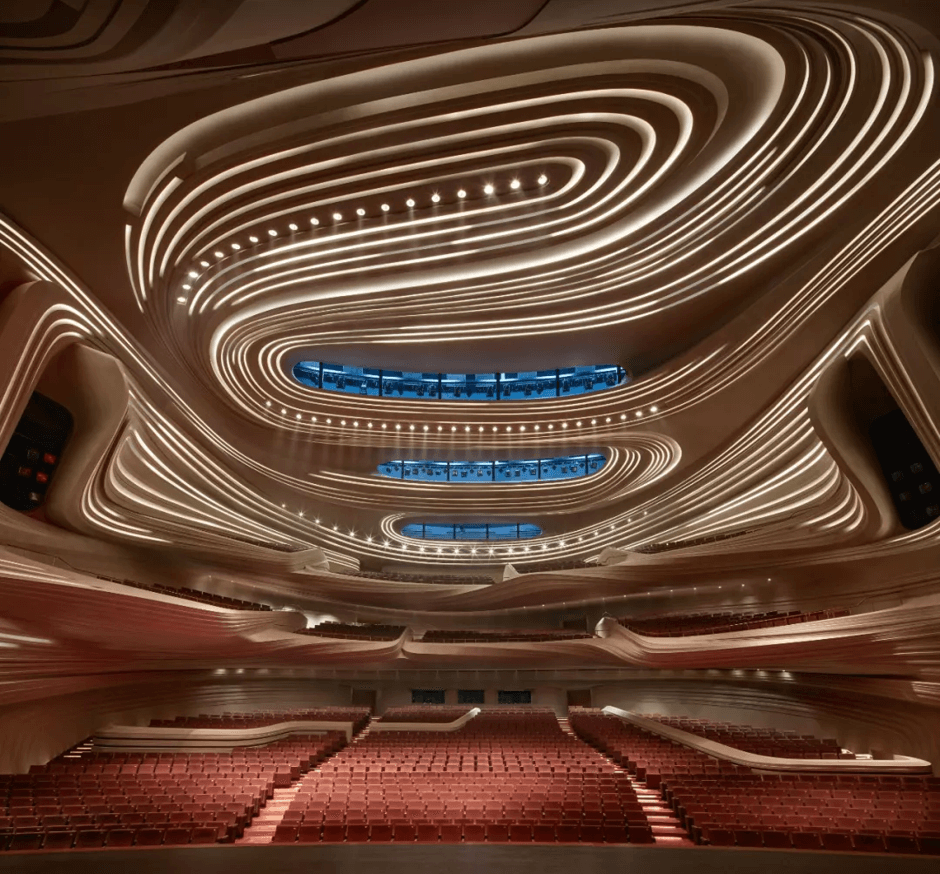China Changsha Meixi Lake International Culture Art Centre
The Changsha Meixi Lake International Culture Art Center for culture and art, designed by Zaha Hadid architects, recently welcomed its first exhibition since its opening – “The Eternity of Flow”.
“The Eternity of Flow” is an immersive exhibition organized by MOTSE. MOTSE is composed of 40 artists and scientists from Shenzhen, whose works use innovative new media technologies and interactive experiences to explore contemporary culture.

The Centre consists of a contemporary art gallery, a 1,800-seat theatre with supporting facilities and a multi-purpose hall. Its architectural language is defined by the walking routes through the site to the surrounding streets.
The three venues act as an ensembly, creating an external courtyard. Pedestrians can enjoy the views of the adjacent Meixi Lake, or access the parks and trails of Festival Island on the lake. The intersection of these walking routes is an excellent venue for outdoor activities and sculpture exhibitions.

Meixi Lake International Culture Art Center is the largest and most widely used cultural center in Hunan province, directly connected to the Line 2 of Changsha’s new subway line.
Since ancient times, Changsha has been an important trading hub and cultural exchange center in China. In addition, Changsha maintains the leading position of domestic cultural media by holding popular cultural performances and shooting popular film and television works in The Grand Theater.
The Grand Theatre can hold a variety of performing arts activities. Its sculpted lobby, bar and suite house provide all front office functions, as well as necessary ancillary facilities such as administrative offices, rehearsal rooms, backstage logistics, cloakrooms and changing rooms.
The center of the museum, which has eight parallel galleries totaling 10, 000 square meters, is an atrium for large-scale installations and events. The museum also has space for community seminars, a lecture hall, a cafe and a souvenir shop.

The advantage of small theatres is that they are more flexible. The 500-seat function room can be adapted to functional needs ranging from mini-theatres, fashion shows, musical performances to banquets and business events by switching to different configurations.

The total area of the three cultural venues is 115,000 square meters, these three cultural sites are independent of each other and have different positioning, still complementing each other. Their different opening hours make the cultural center lively both day and night. With the end of the day operation of the gallery, The Grand Theatre comes to life, while the small theatres have events at all times.
Source: Zaha Hadid Architects

熱門頭條新聞
- In conversation with ‘Ultraman Rising’ director Shannon Tindle: Insights on storytelling, innovation, and collaboration in animation
- Breaking Free: Disney Declares Independence from the Apple App Store
- Warner Bros Discovery confirms Max launch in seven Asian markets
- A look at the winners of the 72nd San Sebastian International Film Festival
- Talpa Studios and Hasbro Entertainment showcased Trivial Pursuit at MIPCOM 2024
- NARAKA: BLADEPOINT Invites You to Dance with the Spirits
- Curve Games Signs Publishing Agreement with Patattie Games for Upcoming Title Wax Heads
- DUBAI STUDIOS SIGNS PARTNERSHIP WITH INTERNATIONAL ACADEMY OF TELEVISION ARTS & SCIENCES
